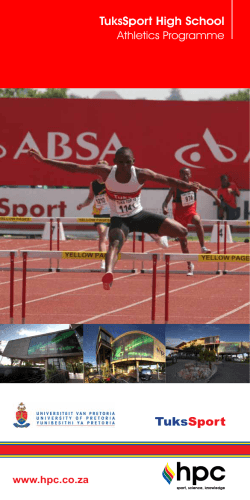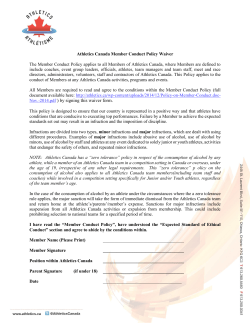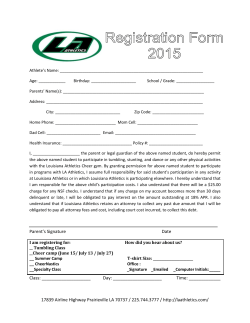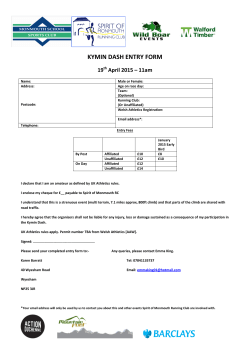
MEMORANDUM - UM Public Affairs
MEMORANDUM TO: President Mark Schlissel FROM: James P. Hackett, Interim Athletic Director Darryl Conway, Associate Athletic Director, Student‐Athlete Health and Welfare RE: Michigan Athletics Review of In‐Game Player Safety Procedures/Communication Plan DATE: April 1, 2015 Following a September 27, 2014 in‐game injury incident, you instructed that Michigan Athletics conduct a thorough review of its in‐game safety procedures and communications plan, particularly regarding the management of head injuries. Michigan Athletics submitted to your office its draft Review of In‐Game Player Safety Procedures/Communication Plan (“the Review”). Our review included the input of the UM Health Service and Health System physicians who are members of the Michigan Athletics medical team. This focused review was part of a larger and ongoing effort to analyze and document the policies, procedures, position statements, and consensus papers related to the health and welfare of student‐ athletes, and to benchmark those components against other NCAA Division I universities. The review and benchmarking process has been led by Darryl Conway, Associate Athletic Director‐ Student‐Athlete Health and Welfare, Dan Hendrickson, MD, Head Team Physician / Director of Medical Services, and James Carpenter, MD, Head Team Orthopedic Surgeon / Director of Surgical Services, but has involved all members of the medical team that are involved with on‐field management. In all, the review covered fifteen (15) major areas, including the medical team model and on‐field staffing and roles and responsibilities; the on‐field communication plan and injury management process; chain of command and return‐to‐play decision making; emergency action plan, cervical spine injury management, and catastrophic injury plan; and a the U‐M concussion management plan and education process among others. This plan has been benchmarked against those of the other Big Ten Conference schools, as well as various institutions of the ACC, SEC, Pac 12 and Big 12 Conferences. The review indicated: The Medical Team model in place is consistent with that of other NCAA Division I institutions; The number and type of medical professionals in place on the field are commensurate with standard practices among NCAA Division I institutions, and that roles are clearly identified; The training and clinical knowledge and abilities of the medical team are consistent with that of medical professionals at other NCAA Division I institutions; and The Department’s policies and procedures related to the health and safety of student‐athletes are reviewed frequently and meet guidelines and best practices established by the NCAA, National Athletic Trainers’ Association (NATA), and other national or international bodies. While the Department believes it is meeting or exceeding best practices within the industry and that the medical team’s plan for the various on‐field communications necessary to ensure student‐athlete health and safety is generally strong, it identified key principles and opportunities for review, reinforcement, and/or improvement: 1. Visualization of the playing field and access to video replay‐ As a means of overcoming the unique challenges presented to personnel viewing live game action from the sidelines, one (1) certified athletic trainer (Associate Athletic Director‐ Student‐Athlete Health and Welfare) who was traditionally stationed on the field was relocated to a position within the press box as a “Spotter” / “Eye‐in‐the‐Sky”. This allowed personnel to better observe the live action on the field from a different and less obscured vantage point, have access to video replay, identify possible student‐athletes that may need further evaluation by a member of the medical team on the field, and communicate immediately and directly with medical team members with the use of two‐way radio. 2014 was the NFL’s third full season to utilize this “eye in the sky/spotter” procedure and its use is growing within college football. (Recommendation implemented in October 2014.) 2. On‐Field communication among Medical Team personnel‐ As a result of the significant ambient noise on the field during a game and the often crowded nature of a sidelines that may limit movement of personnel, two‐way radio communication between Medical Team personnel were added to help increase the effectiveness and efficiency of communication between medical team members. A minimum of two (2) certified athletic trainers on the field, two (2) physician on the field, and other individuals as needed and/or warranted will utilize two‐way radios during the game. These individuals have direct communication with each other and with the Spotter located in the press box. (Recommendation implemented in October 2014.) 3. Documentation to enhance consistency and assist in continued ‘best practices’ reviews‐ Medical Team personnel have documented many good practices that were already in place at the time of the incident to further assure consistency and clarity of protocols, and to aid in transferring that knowledge to current and future Medical Team members. Such documentation also will aid the Medical Team during its normal efforts to critically review pertinent processes and related research, as well as continued benchmarking against other NCAA Division I peer institutions as a means of improving processes integral to the health and safety of the student‐athlete. (Recommendation implemented as part of this review.) Upon completion of the internal review, three external expert reviewers were selected by your office to review and provide feedback to the Background Summary: John P. DiFiori, M.D., Professor of Family Medicine and Orthopedics; Chief, Division of Sports Medicine and Non‐operative Orthopedics, David Geffen School of Medicine at UCLA; Head Team Physician, UCLA Department of Intercollegiate Athletics Timothy Neal, M.S., ATC, former director of Sports Medicine at Syracuse University. Tad Seifert, M.D., Director, Sports Concussion Program, Norton Healthcare; Clinical Assistant Professor of Neurology, University of Kentucky; Team Neurologist, Western Kentucky University; Head, NCAA Headache Task Force Their reviews were extensive, covering all aspects of Michigan Athletics’ in‐game player safety procedures and protocols. Key findings from the external reviewers include: The U‐M Athletic Department in‐game player safety procedures and communication plan meets or exceeds standards. One reviewer said the plan “… is very much in line with best practice standards…” Michigan Athletics has a highly qualified staff of team physicians and athletic trainers who are well‐trained and experienced sports medicine professionals dedicated to providing care for our student‐athletes. Moreover, it is noted that Michigan Athletics is appropriately utilizing the resources of the University Health Services and the University Health System. While these observations are encouraging and reaffirming, it is noted that opportunities for refinement of our processes and communications were identified as well. Many of the reviewers’ recommendations have been implemented; in several instances, the recommendations only required clarification or greater description of already‐existing practices and processes. In other instances, reviewers recommended implementing practices and procedures that are already current practice at Michigan Athletics. Both examples illustrated the need to more fully describe the Michigan Athletics’ medical team structure, policies and procedures in various parts of the Review. A smaller number of more substantive recommendations were made as well and Michigan Athletics has or will immediately implement those improvements that are conducive to its medical team model. These include: Providing more detail of the specific roles and responsibilities of each sideline physician; Adding the Team Neurologist to the group of medical team members who are on sideline radio communication; Increasing the frequency of review of current position statements and consensus documents issued by relevant medical and athletic associations from every two years to annually; Identifying opportunities for mock, unannounced drills and increasing overall the opportunities for practice sessions regarding cervical spine injury management; and Confirming additional education regarding concussion management will be provided to coaches and student‐athletes as applicable following a concussion event incurred by a student‐athlete; These modifications are reflected in the attached final Review. This document is the final, current summary of the policies, protocols and processes in place at Michigan Athletics to manage the provision of in‐game medical services to student‐athletes. This review process, both the internal and external phases, highlights the complex environment in which sideline (in‐game) medical services must be provided. It also is a continuous improvement process, and Michigan Athletics recognizes the importance of ongoing review. We will continue to review the relevant professional literature, review the processes and rules in place in other similarly complex environments, and look for ways to implement rules that further promote clarity and order in our sideline medical procedures. Attached to this memorandum are: The Review of In‐Game Player Safety Procedures/Communication Plan, reflecting modifications to the sideline processes and protocols recommended by the external reviewers and now implemented at Michigan Athletics; and Michigan Athletics’ Summary Response to External Reviewers Comments and Recommendations. The latter document is intended as Michigan Athletics’ complete response to the external reviews and is presented as an appendix to the Review. The external review of our procedures and practices was a valuable step in our overall review process. We appreciate the insights provided by these external experts and look forward to continuing to employ best practices to ensure the best possible athletic training and medical care for our student‐athletes.
© Copyright 2025












